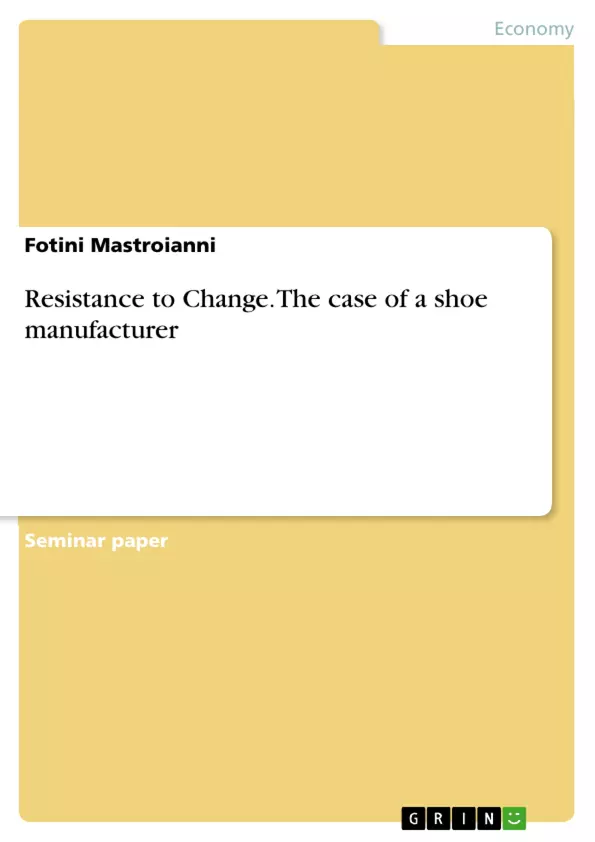An enterprise is a dynamic sociotechnical system which should survive in a continuously changing environment to stand the external pressure, satisfying thereof the demands of its external and internal customers.
The main goal of every system is its preservation in time. This preservation can be achieved through its continuous adaptation to external and internal pressures and thus through constant change and evolution. The concept of evolution involves the concept of change. Therefore, change is a concept closely linked to survival, growth and success of any system.
However, a key element of each system is the man - employee. The employee with his/her work contributes directly to achieving the objectives pursued and leads and organizes the continued growth and development of the system to which s/he belongs. The employee as human nature seeks the development and pleasantly accept change . Without the effort to change, the society would not have progressed as well as technology, thinking and science. From a psychological point of view, the man would feel empty, sterile, unfinished, s/he would be inactive and passive, would lose confidence and creativity.
However, there are many studies and rich literature, claiming that the resistance of employees in an organizational change is almost automatic and certainly unexpected, and it is a key problem that the management of each organization / company has to face successfully to complete the task of introducing some change.
This paper focuses on this issue, approaching it both theoretically and practically. The results are of considerable interest, since the study was based on a fairly wide range of literature, but it has also successfully used a modern method of processing questionnaires which helped to export some initial conclusions.
The research was conducted in November 2004 in a major shoe manufacturer in Greece owning a wide retail chain. The sample was fairly small and limitations of the research are considered the relative small sample of the respondents as well as the fact that it concerned only one company.
Inhaltsverzeichnis (Table of Contents)
- Introduction
- Chapter 1 - Literature Review
- 1.0 The concept of Change
- 1.1 The equation and evaluation of the necessity of change
- 1.2 Types and levels of change
- 1.3 Purpose of introducing changes
- 1.4 Stages of the change process
- 1.5 Design of Change
- 1.6 Change implementation
- 1.7 Techniques of introducing changes
- 1.8 Management by walking around
- 1.9 Team building
- 1.10 Communication
- 1.11 Attitudes of Employees towards change
- 1.12 Causes of Resistance
- Chapter 2 – Research Methodology
- 2.0 Object and goal of the research
- 2.1 Research process
- 2.2 Profile of respondents
- 2.3 Presentation of research results
- 2.3.1 Assurance Testing
- 2.3.2 Frequency distribution
- 2.3.3 Comparison of frequencies
- 2.3.4 Relationships
- Chapter 3 – Conclusions – Suggestions
Zielsetzung und Themenschwerpunkte (Objectives and Key Themes)
This paper aims to explore the resistance of employees to organizational change, using a case study of a major shoe manufacturer in Greece. It examines this issue both theoretically and practically, drawing on a range of literature and utilizing a modern method of processing questionnaires to produce initial conclusions.
- The concept of change and its relationship to survival, growth, and success of organizations
- The different types and levels of change that companies face
- The various causes of resistance to change, including cultural, social, organizational, and psychological factors
- Techniques for introducing changes, such as Force Field Analysis, Management by Walking Around, team building, and effective communication
- Employee attitudes towards change and the factors that influence their reactions.
Zusammenfassung der Kapitel (Chapter Summaries)
Chapter 1 provides a comprehensive review of the literature on organizational change, exploring the concept of change, its necessity, types, and levels. It also examines the different stages of the change process, the design of change, implementation techniques, and the various factors that contribute to resistance to change.
Chapter 2 delves into the research methodology employed in the study, outlining the objective and goal of the research, the research process, and the profile of the respondents. It presents a detailed analysis of the data collected through questionnaires, including frequency distributions, comparison of frequencies, and correlation analysis.
Schlüsselwörter (Keywords)
The main keywords and focus topics of this text are: organizational change, resistance to change, employees, management, change management, employee attitudes, communication, Force Field Analysis, team building, and case study.
- Quote paper
- Fotini Mastroianni (Author), 2016, Resistance to Change. The case of a shoe manufacturer, Munich, GRIN Verlag, https://www.grin.com/document/444415



